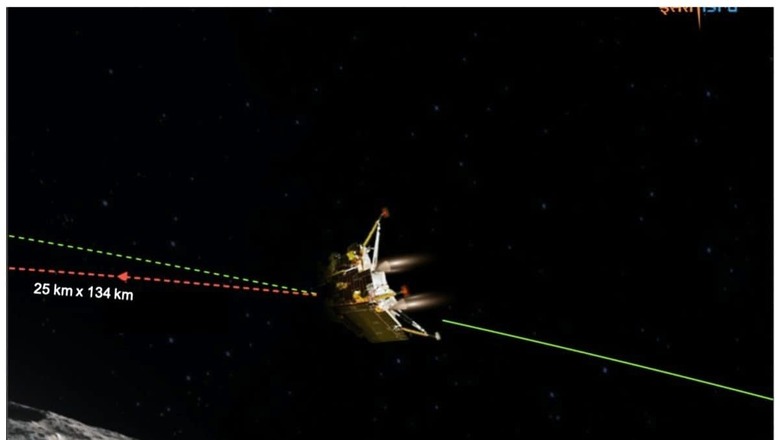
views
India’s third mission to the moon has put the spotlight back on the country’s inter-planetary expeditions and the long quest by astronomers to unravel the mysteries of space. Apart from demonstrating a successful touchdown on the moon, Chandrayaan-3 will answer some intriguing questions.
Chandrayaan-3 LIVE Updates
The mission comes at a time when major space-faring countries are returning to the moon after 50 years in pursuit of water and critical minerals locked in the lunar exosphere and surface. Chandrayaan-3, too, has seven payloads aboard its lander and propulsion modules.
In an exclusive interview with News18, Professor Annapurni Subramaniam, senior astronomer and director of Indian Institute of Astrophysics (IIA), Bengaluru, said the moon mission marks a key moment in India’s space journey. Excerpts from the interview:
Apart from being a landmark achievement, why is Chandrayaan-3 significant for astronomers?
There has been a renewed interest in the moon due to evidence of water molecules on its surface. But recent discoveries have also shown that there are minerals out there, which could be used. So, it is important for us to know that. We have been looking at the moon and the solar system from earth for decades.
So far, we have only been dependent on data from various missions to understand the solar system. We were not actively collecting, sampling and analysing this data in our laboratories. But a successful landing can give us the opportunity to go there and understand how much of it is actually present.

As astronomers, we have also been trying to understand the evolution and formation of the solar system. How the sun and planets are formed and why the solar system is the way it is now. There are many other planets, but they are all different. The inner ones are rocky, while the outer ones are gaseous, some have moons, while some do not – what is guiding their formation and evolution?
Where does India stand in terms of space exploration and research?
ISRO has established its capacity really well and could enhance its skill and technology with a moon landing. Every country has its own way of reaching the moon. India does it in an economical way though it takes more time. But there is no race now, it is about reaching there perfectly. It is the third time we are going to the moon, and ISRO has already mastered the process. Chandrayaan-2 orbiter has been monitoring the lunar surface at an extremely high resolution and will play an important role in communicating with Chandrayaan-3 lander.
Only three countries have been able to successfully land on the moon in 50 years. Why is a lunar touchdown so difficult?
We take many things for granted when we are on earth. The atmosphere and gravity both change when we enter space. Once the lander reaches the lunar orbit, we cannot assume that it will land on the table top. It is heavy and can land on a haphazard, non-uniform surface. Even if a couple of things go wrong, we still have to ensure that it works and does not tilt. It has been tested multiple times but, once it is on the moon, the process will be entirely automated. The lander module will have to make a decision, assess the probability and see if it is okay to land. It has to perform such complex tasks in an automated way. Therefore, the software has to be fed with accurate information, so that it can take an informed decision and land safely.
Chandrayaan-3 lander has a much more robust software. Also, there are more sensors that can provide data, so it can make a better decision. We have better maps than the previous mission. So, once the lander is in its final orbit, it has to find the right distance from the ground, accurately determine the speed and make the landing.
How confident are you of the success of the mission this time?
ISRO has performed many manoeuvres from the launch till it reached the lunar orbit. Getting captured by the moon’s gravity was critical and we achieved that too. The mission has passed many critical steps. Now, the lander has to de-boost to a slightly lower orbit. This is yet another small but important step and we can definitely do it. We will reach there without much of an issue. But it is the last 30 km that will be quite crucial. The parameters of space are vast and involve complexities. There will always be a small non-zero probability that it can go wrong and we cannot eliminate that. But I’m quite certain that we will make it this time. A huge amount of preparation has gone into it and Chandrayaan-3 has the highest probability of being successful.
ISRO has announced its next space mission to the sun – Aditya L1. Why does India want to go to the sun?
It is a happy moment for the astronomers because Indian space missions are looking at the moon and sun. With AstroSat, ISRO demonstrated that we can operate complex instruments in space. But Aditya L1 is much more complex. It will go till the L1 Lagrange Point, almost 1.5 million km from earth and be placed in a halo orbit perpendicular to the line connecting the sun and earth. It will be the first time we will go so close to the sun. The Aditya L1 satellite is already integrated and ready for launch.
The sun is an active star with magnetic fields. The solar activity has a periodicity of 11 years. During this period, sunspots form and cause plasma ejections. We have many electronic assets in space, which we need to protect from damaging effects of these charged particles. There are many interstellar missions coming up, so we need to monitor the sun closely.
Science-wise, we need to understand what is there in the sun and how it releases its energy. We know that corona (the sun’s outer layer) is extremely hot. But, why is it as hot as the centre of the sun? It’s still a mystery. How does the plasma come out and how do the magnetic fields guide and control them? We have created a complex instrument – the ‘coronagraph’ – which will observe the corona by blocking the solar disc. We look forward to predicting solar bursts, coronal mass ejections (CME) and protecting humanity as well as assets out there.

















Comments
0 comment